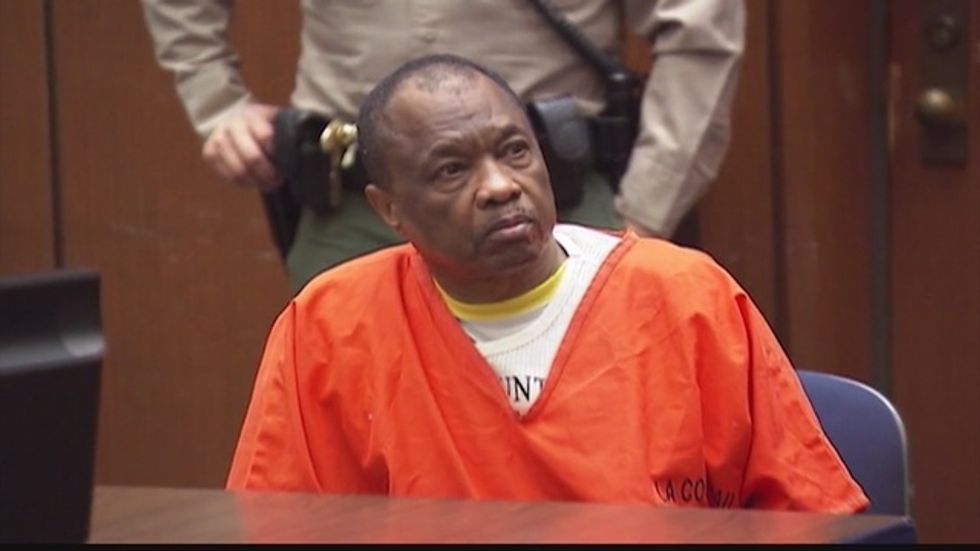
Lonnie David Franklin Jr. (Image source: KTTV-TV)

LOS ANGELES (TheBlaze/AP) -- A serial killer preying on vulnerable young black women on the rough streets of south Los Angeles eluded police for two decades until someone rifling through a dumpster in 2007 noticed red fingernails poking out of a garbage bag.
Inside was the body of Janecia Peters that provided clues connecting her slaying to nine others and eventually led to the arrest of a suspect in the "Grim Sleeper" slayings.

A prosecutor displayed charts, diagrams, photos and DNA test results to jurors Monday to make her case that Lonnie Franklin Jr. was a killer hiding in plain sight as he shot and strangled women, many prostitutes, and dumped their bodies in alleys not far from his home.
"Ten young women," Deputy District Attorney Beth Silverman said during closing arguments in Los Angeles Superior Court. "All of them cruelly murdered by that man."
Franklin, 63, a former garbage collector who also worked as a mechanic for the Los Angeles Police Department, could face the death penalty if convicted of the slayings of a 15-year-old girl and nine young women. He has pleaded not guilty to murder, and to attempted murder in the case of a woman who survived.
"How do we figure out what happened here? How do we know who committed these crimes?" Silverman said. "Ten of the victims can't tell you themselves. The defendant took their voices when he brutally murdered them...The evidence in this case is the voice of the victims."

Franklin is accused of murdering these ten women, going back to 1985, KTTV-TV reported.
Debra Jackson, 29, found dead from three gunshot wounds to the chest in an alley on Aug. 10, 1985;Henrietta Wright, 34, shot twice in the chest and found dead in an alley on Aug. 12, 1986;
Barbara Ware, 23, shot once in the chest and found dead in an alley on Jan. 10, 1987;
Bernita Sparks, 26, shot once in the chest and found dead in a trash bin on on April 15, 1987;
Mary Lowe, 26, shot in the chest and found dead in an alley on Nov. 1, 1987;
Lachrica Jefferson, 22, found dead from two gunshot wounds to the chest in an alley on Jan. 30, 1988;
Alicia Alexander, 18, killed by a gunshot wound to the chest and found in an alley on Sept. 11, 1988;
Princess Berthomieux, 15, strangled and discovered in an alley in Inglewood on March 19, 2002;
Valerie McCorvey, 35, strangled with a ligature and found dead at the entrance to an alley on July 11, 2003 Janecia Peters, 25, shot in the back and found dead inside a sealed plastic trash bag in a trash bin in an alley on Jan. 1, 2007.
Silverman spent hours discussing how ballistics tests showed that most of the women had been killed by the same gun, their bodies deposited in similar places and Franklin's DNA was found on victims and the zip tie of the trash bag holding Peters' body.
But defense lawyer Seymour Amster said that prosecutors had built a circumstantial case using inferior science and that patterns they attempted to show were nothing more than illusions.
He compared government work on the case to a rancher who calls himself a marksman after drawing bullseyes around bullet holes in his barn.
Amster, who is to continue his argument Tuesday, said Franklin was obsessed with sex and could have innocently spread his DNA to the breasts of murder victims because he often gave women bras and other garments.
"His DNA is probably on more women out there than we'll ever know," Amster said, noting it wasn't a morality case.
Franklin is one of three men to face charges in slayings originally attributed to a single killer called the "Southside Slayer" during the crack cocaine epidemic, when crime spiked. All but one of his alleged victims had cocaine in their bodies.
The killings Franklin is charged with were later dubbed the work of the "Grim Sleeper" because while the first victim was found in 1985 and the last in 2007, there was a 14-year gap when no bodies turned up, although prosecutors believe his violence never ceased.
Police had figured that the killer laid low after one woman survived a gunshot in 1988 and told her harrowing account to police.
Silverman said survivor Enietra Washington provided the blueprint that explained how Franklin preyed on all the other victims.
Washington described being shot in the chest and sexually assaulted in 1988 as she sat in Franklin's orange Ford Pinto. She said her attacker snapped a Polaroid of her as she slipped into unconsciousness and was pushed from the car.
Franklin was finally arrested in 2010 after a police officer posing as bus boy at a pizza parlor birthday party collected DNA samples from a pizza crust and napkin that connected him to the victims.
Police searching his house found a snapshot of a wounded Washington slouched over in a car with a breast exposed, along with a trove of other photos of women, including Peters.
Family members of the victims wept and some doubled over to avoid looking at photos of partly nude and decomposing bodies shown to the jury on a big screen.
Franklin, wearing black-framed glasses and a blue dress shirt, stared straight ahead, showing no emotion.
Silverman pointed out that Peters' body was discovered only a block down the alley from where another victim, Bernita Sparks, was found partially clad in a dumpster two decades earlier - one of many coincidences she noted.
"Most of these victims have been dead for over 20 years," she said. "It's time that justice is served in this case."
–